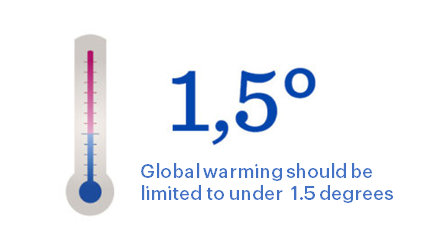Research and knowledge steer climate objectives
Climate change mitigation is necessary for life. Global warming fundamentally affects the viability of our planet. The impacts of climate change vary by region. The weakening living conditions caused by global warming significantly reduce the subsistence possibilities of humans and can increase the number of climate refugees up to hundreds of millions. Global warming has tremendous human and social impacts.
The information we have on climate change and ways to combat it are based on scientific research. Finland is a pioneer in the competence and RDI activities necessary to find solutions for climate change. Research and research-based knowledge steer our climate objectives and measures. In accordance with a sustainable and equitable climate policy, Finland shall become a carbon-neutral society that provides people with opportunities to earn a livelihood and pursue an occupation. We need to create the conditions necessary for Finnish businesses to develop the products and services that are in demand worldwide.

Climate change
- Climate change refers to global warming caused by the dramatic increase of greenhouse gas emissions in our atmosphere. Greenhouse gas emissions include, among others, carbon dioxide, methane and nitrous oxide.
- A significant percentage of the greenhouse gas emissions are caused by carbon dioxide released as a result of the use of fossil fuels.
- In 2017, global greenhouse gas emissions totalled about 53.5 billion tonnes of CO2 equivalent.
- Finland’s greenhouse gas emissions total approximately 56.1 million tonnes each year. Finnish emissions per inhabitant are considerably higher than the global average.
- The only way to combat climate change is for the world to achieve carbon neutrality and net negative emissions.
1 Climate policy objectives
The Paris Agreement sets forth the objectives for global climate policies. The central aim of the Agreement is to keep the global temperature rise this century well below a 2°C increase from pre-industrial levels and to pursue efforts to limit the temperature increase even further to 1.5°C. Akava’s objective is to ensure that Earth remains viable for future generations. Efforts shall be made to endeavour to resolve the primary objective of the climate policy, particularly on the global level.
According to the Intergovernmental Panel on Climate Change (IPCC), in order to limit the increase of the average global temperature to 1.5°C by the end of the century, emissions will need to be reduced as to ensure that net zero emissions have been achieved globally by 2050. Akava views it as important that Finland and the EU adopt a policy that would enable for the limitation of global warming in a manner that is in keeping with the objectives of the Paris Agreement.
In Finland’s Climate Change Act (Ilmastolaki, 609/2015), the long-term greenhouse gas emission reduction objective is a minimum reduction of 80 per cent by 2050 in comparison to the emissions level measured in 1990[1]. In December 2018, eight Parliamentary parties published a joint climate policy statement[2] that proposed the tightening of the current climate objectives. By virtue of the Climate Change Act, the Finnish Government appoints a Climate Change Panel, which holds a significant position in the dialogue between science and politics. Akava wants to contribute to the preparation of a new climate policy that includes measures that would pursue to limit global warming to 1.5°C. Akava wants the Climate Change Act to be amended to correspond more broadly with the objectives for climate change mitigation and adaptation.
The European Commission is currently preparing a new long-term climate strategy. The Commission has proposed to the Member States the objective of carbon neutrality by 2050. Akava believes that Finland must further tighten its own climate policy objectives before we can demand that the EU take a more dynamic role in global climate policies. In practice, this means that Finland shall do its part to achieve carbon neutrality by no later than 2040.
Above all, Finland’s climate policy shall endeavour to reduce emissions and grow the nation’s carbon sinks. In addition to improving and expanding the activities of the emissions trading system (ETS), the climate policy objectives shall be extended to building, real estate, transport, agriculture and forestry and land use. Circular economy plays an important role in emission reduction. A large percentage of the emissions are attributed to the use of natural resources and industrial production, but only a minor percentage of the natural resources are retained in material loops. In order to achieve the objectives, we must increase research, development and innovation activities and promote technological development.
Climate change adaptation must be taken more into consideration as a key aspect of the climate policy. The IPCC’s report indicated that climate change has progressed to the point at which we are already starting to be in a hurry to implement any effective adaptation methods. Climate change adaptation shall be advanced globally, particularly in developing countries, where adaptation refers to the safeguarding of the necessary living conditions. As it concerns Finland, climate change adaptation signifies the creation of action models, for example, that are intended to protect built-up areas and to safeguard the conditions for agriculture and forestry.
With the help of a systematic and sustainable climate policy, Finland can formulate solutions that will allow for the achievement of the global climate objectives. A climate policy succeeds when citizens feel that it is fair and they are given the opportunity to participate in the preparation and implementation of that policy. The possibility for different generations to influence and contribute to climate work can be promoted through generation-oriented fairness. Akava wants the Finnish population to have the opportunity to contribute to climate change mitigation and adaptation. It is important to include wage earners in all policy actions concerning the planning and monitoring of the climate policy.

Akava’s climate policy objectives
- Global warming shall be limited to 1.5°C by the year 2050. Finland’s Climate Change Act shall be reformed to correspond to the new climate objectives.
- The EU shall tighten its objectives to enable the achievement of carbon neutrality well before 2050.
- Finland shall achieve carbon neutrality by no later than 2040.
- Finland shall become the most climate-smart country in the world and a leading developer of solutions for the prevention of climate change.
- We need to get the entire Finnish population to contribute to efforts for the good of our climate.
2 Climate policy of the European Union
The European Union laid out its emission reduction targets when preparing for the Paris Agreement negotiations in 2014. To this end, the European Council approved the binding target to cut emissions in the EU by at least 40% below 1990 levels by 2030. In order to achieve the target, fields within the EU emissions trading system sector (ETS) will have to cut emissions by 43% and fields outside of the ETS sector, or the so-called effort sharing sector, by 30% when compared to the level in 2005.[3] The targets for the land use sector, as specified within the EU climate policy framework, have a significant impact on the objectives and implementation of Finland’s climate policy.

Tightening EU emission reduction targets
It is Akava’s opinion that the EU’s long-range target should be to achieve carbon neutrality long before 2050. This would require the reform of the minimum targets for the emissions trading system for the years 2021–2030, so that the burden of the increased reduction might be distributed more evenly over the remaining target period until 2050. The emissions trading system shall be expanded to new sectors and emissions trading concerning flight traffic shall be expanded, through international agreement, to include flight traffic worldwide. The expansion of emissions trading is not an end in itself, but rather it shall have clear climate and economic benefits. The EU land use sector shall develop in a way that strengthens its carbon sinks. It is Akava’s opinion that the EU must draw up a credible operating model for the achievement of the 2050 emission reduction targets. The ability and willingness of companies operating in the EU region to make the necessary investment decisions requires certainty in the long-term business environment.
The EU emissions target for 2030 shall be updated to correspond to the 1.5°C objective. For this reason, the EU’s targets and mechanisms shall be updated, also as they concern the emissions trading and effort sharing sectors. The free allocation of emission allowances can still be realised in fields that have a significant risk of carbon leakage. The EU climate policy and, in particular, emissions trading have the ability to affect the increase in risks of carbon leakage. The EU must research and prepare methods by which carbon leakage can be prevented. Such methods might be, for example, a carbon customs duty or carbon taxation on products that are brought from outside of the EU.
An equitable transition
The EU must formulate recommendations for an equitable climate change transition as a means of encouraging the Member States to take the impacts of climate actions into consideration as they concern people’s living conditions and physical and mental health. In many fields, carbon neutrality calls for new types of competence and retraining. As a means of supporting an equitable transition, the EU must establish recommendations that cover all the different policy sectors and a comprehensive programme for the organisation of opportunities for retraining and continued learning.

Akava’s climate policy objectives for the EU policy
- The EU shall achieve carbon neutrality long before 2050.
- The minimum objectives for the emissions trading system shall be tightened for the years 2021–2030.
- The emissions trading system shall be expanded to include new sectors. Emissions trading as it concerns flight traffic shall be expanded.
- The EU’s objectives for the emission reduction targets of the effort sharing sector shall be reformed to correspond to the 1.5°C objective by 2050.
- The EU shall draw up recommendations for an equitable transition and a programme that provides opportunities for continued learning.
- The EU shall include the promotion of circular economy in its overall climate policy.
3 Finland’s climate policy
Finland’s climate policy is outlined in the Climate Change Act, the National Energy and Climate Strategy[4], and the medium-term climate change policy plan[5]. It is Akava’s opinion that Finland’s Energy and Climate Strategy must be updated with new measures that are in keeping with the 1.5°C objective. The new climate change strategy must be expanded further to cover all administrative branches, and the steering of the drafting process must be transferred to the Prime Minister’s Office.

It is Akava’s position that Finland’s climate policy shall be steered using a market-based approach. A market-based approach signifies the reduction of emissions by the generation of a price for emissions, as determined by markets created for that purpose, that would be aimed at the source of the emissions. The emissions trading system operates with a market-based approach. The price of emissions external to the emissions trading systems is not determined by the markets, but rather, through taxation. The transition to a carbon-neutral society might also be supported by the reform of the tax system. Sitra, for example, has issued a proposal for a sustainable development tax reform. Finland’s climate policy actions shall be selected on the basis of their ability to reduce emissions in an economically cost-effective manner.
Climate policy in the energy sector
Finland’s current long-term objective is to make its energy supply carbon neutral and based heavily on renewable energy sources.
In order to achieve this objective, Finland has decided, among other things, to halve the energy consumption of imported fuels by 2030, to phase out the use of black coal by 2030, to increase wood-based energy, to promote the use of biogas and to develop the production of electricity and heat generated from renewable energy sources.
In terms of energy production, the primary methods of achieving the new, stricter emission reduction targets involve discontinuing the use of fossil fuels and replacing it with the use of renewal fuels and biofuels at a faster rate than originally planned.
The use of energy peat will be inherently reduced as a result of market-based emissions trading. However, as a domestic fuel source, peat, along with wood fuel, holds significance in terms of security of supply.
It is Akava’s opinion that the primary methods for realising the carbon-neutral target for our energy supply include:
- The accelerated reduction of imported oils as an energy source
- The controlled reduction of the use of peat in energy production
- The accelerated use of different forms of renewable energy production
- Improvements in energy efficiency
- The accelerated use of energy storage
- The utilisation of smart grids
- The accelerated use of demand response systems.[6]
In order to increase the use of renewable energy production, improvements shall be made in the conditions required for production of all sizes. There is a need for both large-scale production and distributed microgeneration projects. The renewal of the energy production system shall be advanced with the help of taxation and regulation. It is Akava’s opinion that, in order to accelerate the use of renewable energy sources, Finland must develop emission recovery systems, increase energy storage systems and initiate the development of the electricity markets in order to get distributed resources and smart equipment to the markets.

Climate policy in other sectors
A significant portion of the emissions from the external sector of the emissions trading system arise from consumption, movement, building-specific heating and food choices. The increase of energy and material efficiency through training and increased knowledge plays a key role. When planning actions to reduce emissions within the effort sharing sector, the emphasis shall be placed on cost efficiency. Climate actions shall be made without complicating operational conditions for the business sector.
The current Energy and Climate Strategy sets the most prominent emission reduction objectives for transport. Transport must achieve the highest level of emission reduction, since it accounts for approximately 40 per cent of the total emissions of the effort sharing sector. The objective, as stated in the Energy and Climate Strategy, is for the transport sector to halve its emissions by 2030 in comparison to the levels in 2005. This objective will not be sufficient, however, once the national targets for carbon neutrality are tightened.
The transport sector will need to undergo significant changes in terms of urban planning, the use of public transport, fuels and motive power. There needs to be a dramatic increase in the number of charging stations for electric cars and other measures to reduce the energy consumption of transport. The possibilities that digitalisation offers in terms of transport emission reduction must be taken into use as comprehensively as possible. Within the effort sharing sector, in particular, actions that will bring about costs include the increase of the share of biofuels for transport and the increase in the number of electric cars. With the current actions alone, it will be difficult to achieve the objectives, unless the technologies become radically less expensive than they are now. Different alternative pathways to reach the objective have been outlined, for example, in Sitra’s report on cost-effective means of emission reduction. It is Akava’s opinion that transport emissions shall be reduced through a comprehensive programme and market-based mechanisms that enable for the achievement of carbon neutrality by 2040. Taxation shall be used to create a gradually steepening price steering for transport greenhouse gas emissions.
Energy efficiency has a great impact on the greenhouse gas emissions caused by the building process and the buildings themselves. The building sector must promote energy-efficient building methods and wood construction, for example, by establishing regulations that limit the carbon footprint of buildings. The possibilities within repair construction are more extensive than within new construction. New incentives must be created for repair construction that would motivate energy renovations.
The current objectives for agriculture and land use have been set at a lower level. As we move forward, there will be a need to establish, for the agricultural sector, reduction objectives that are commensurable with other sectors as a means of achieving carbon neutrality. The potential of carbon sink development plays an important role in this effort. The fastest and most effective way to reduce emissions in agriculture without compromising production is to enact measures that target peatlands.[7] In Finland, peatlands cover approximately 250,000 hectares of its land area.
Finland must promote measures that support the strengthening of the principles of circular economy in consumption and production. Finland has an opportunity to serve as a forerunner in circular economy. In practice, one of the easiest actions a consumer can take to ensure a closed-loop system for materials is to reduce the amount of food waste. The total household food waste is an estimated 120–160 million kilos per year. It is Akava’s opinion that food waste must be reduced to half of the current level by 2030.
As the production potential of the forests increases, the exploitation potential also increases and, therefore, the preservation of nature’s diversity calls for improvements to the current methods used to enhance biodiversity. Akava believes that instead of focusing on the felling volume, it is more relevant to focus on steering wood processing towards such products that bind carbon for as long as possible during their life cycle. The wood processing rate shall be clearly increased over the current rate and directed primarily towards building materials.
Young people play a significant role in terms of climate change mitigation. They, in particular, have the right to be heard when it comes to decision-making regarding climate change, and their concerns must be taken seriously. Akava endeavours to offer young people a platform to be heard and opportunities to contribute to climate actions within their workplaces and educational institutions. It is Akava’s opinion that there should be increased teaching on climate change on all levels of the education system. The prevention of climate change requires society to realise expansive changes in consumer behaviours and production methods. In terms of social change, the media also bear a significant responsibility for providing accurate climate information that is based on scientific research.
Climate change adaptation
Adaptation is a fundamental part of the overall climate policy. As a means of advancing adaptation, action models shall be created, for example, to protect built-up areas from water damage due to, among other causes, sea level rise. The changes taking place in agriculture are related to the increase in crop damage and changes in farming conditions. Forestry is being affected by possible snow-free winters that hamper the logging process. Efforts must be undertaken to begin to monitor and update climate measures with a tighter timetable and as a higher priority. Akava proposes that the Government, when drawing up its annual plan concerning the public economy for the next framework period, shall also draft an assessment that covers the realisation of climate change mitigation and adaptation and the related financial risks. The Government shall allocate available resources more flexibly between administrative branches so as to ensure that the climate policy is better resourced and steered. As a means of developing climate change management, Finland’s climate policy shall be drafted, and regularly updated, under the leadership of the Prime Minister’s Office.

Climate policy must be market-based in nature.

2040 – Transport emissions must be reduced to the extent that enables for achievement of cabon neutrality by 2040.

The food waste from Finnish households totals 120–160 million kilos per year. This objective is to halve this amount by 2030.
Akava’s objectives for Finland’s climate policy
- As Finland’s emission objectives become more rigid, the national Energy and Climate Strategy shall also be updated and incorporate actions that are primarily market-based.
- In order to reduce emissions, the energy sector shall accelerate the rate at which it takes renewable forms of energy production into use.
- Correspondingly, an acceleration of the rate at which renewable forms of energy production are taken into use requires the development of emissions recovery systems, an increase in energy storage systems and the facilitation of smart electricity grids at the national level.
- The power system shall be renewed in a way that enables for the exploitation of a distributed energy supply for energy production.
- Transport emissions shall be reduced through a comprehensive programme and market-based mechanisms that enable for the achievement of carbon neutrality by 2040.
- Efforts to reach carbon neutrality in the agricultural sector call for the establishment of reduction objectives that are commensurable with other sectors. Actions shall be sought, in particular, with the help of the mechanisms utilised in the new programme period of the EU’s common agricultural policy (CAP).
- The wood processing rate in Finland shall be clearly increased over the current rate and directed primarily towards long-lasting goods, such as building materials.
- The climate impacts of food shall be reduced, for instance, by minimising food waste. Food waste must be reduced to half of the current level by 2030.
- The roadmap for circular economy shall be realised as part of Finland’s climate policy.
- Climate education shall be reinforced in early childhood education and at the different educational levels.
- The educational system shall be reformed by developing content based on research concerning climate change prevention for the different levels of education and for different disciplines. Climate change prevention must become a civic skill. All those graduating from our country’s university-level institutions shall have a mastery of the fundamentals of climate change.
- As a means of developing climate change management, Finland’s climate policy shall be drafted, and regularly updated, under the leadership of the Prime Minister’s Office and with the participation of the nation’s citizens.
4 Fairness of the climate policy

The process of planning the national climate policy has largely overlooked the position of wage earners, and more broadly, the country’s citizens, within this changing environment. The planning of nationally-significant climate actions should, however, also involve the participation of citizens in devising measures that will have far-reaching and deep impacts on the society at large.
When planning climate actions, it is vital that citizens be encouraged to participate and engage in genuine dialogue. Climate issues must be communicated clearly and persistently.[8] The climate policy must be predictable in nature in order to make it as easy as possible for companies and citizens to plan for their future. Insecurity about, for example, transport costs and energy taxation decreases the financial activities and willingness of the business sector and private citizens.
It must be possible to use economic instruments to steer consumption towards more sustainable alternatives from a climate perspective. Citizens must be given the opportunity to easily compare the carbon footprint of the products and services available on the market. Actions related to climate change must be as cost-efficient as possible, and any burden on the consumers shall be distributed evenly so as to safeguard the livelihood of those in the weakest position.
More attention shall be paid in climate policy planning and realisation to the equity of the impacts of any proposed climate actions. Special attention must be paid to the following aspects:
- Equality of citizens
- Position of wage earners
- Operating conditions for companies
- Changes to working life and business
Akava proposes that civil society actors, such as labour market organisations, should be given the opportunity to be more comprehensively involved in the planning of the national climate policy.
In order to promote a participatory climate policy, workplaces shall increase the dialogue between employers and employees concerning workplace measures to reduce emissions. A framework for co-operation shall be established for the purpose of helping workplaces to agree on the types of climate actions that will be taken within the workplace.
Akava believes that it is important to create a model for climate discourse that enables for dialogue on climate actions within the workplace. This can be included in, for example, the Act on Co-operation within Undertakings. Functional practices and solutions for climate action can be found on the workplace level through collaboration. The participation of personnel furthers the commitment to climate actions in the workplace. It creates a more solid foundation from which to find sustainable solutions.
Our social structures are changing in different ways as a result of climate change. When planning climate actions, it is vital to safeguard trust in the future.

Everyone must be encouraged to participate in climate work.
Akava’s objectives concerning fairness
- More attention shall be paid in climate policy planning and realisation to the equity of the impacts of any proposed climate actions. Climate actions shall be as cost-efficient as possible and the livelihood of those in the weakest position shall be safeguarded.
- Citizens shall be given the opportunity to easily compare the carbon footprint of the products and services available on the market.
- An assessment shall be drawn up regarding the realisation of climate change mitigation and adaptation that is updated with new measures and includes an evaluation of the subsequent costs and their impact on the sustainability gap.
- Civil society actors, such as labour market organisations and NGOs, shall be more comprehensively included in the planning of the national climate policy.
- A model for climate discourse shall be created for workplaces so that the employer and representative of the personnel might engage in dialogue about climate actions within the workplace. This can be included in, for example, the Act on Co-operation within Undertakings.
5 Innovations for the prevention of climate change
Climate change mitigation offers abundant possibilities. New innovations can be used to facilitate an even more effective climate policy. Innovations related to solutions for climate change can create new, significant business opportunities for Finnish companies and serve as a notable source of economic growth. In order to succeed in innovation activities related to climate change, Finland will, however, need more substantial investments in innovation activities.
Investments are needed for innovation activities in, among others, the following fields:
- Carbon recovery and storage
- Biofuel and biomaterials
- Smart grids and energy storage
- Carbon-free steel and concrete
- Wood construction and new uses for wood
- Carbon sequestration of agricultural land
Broad innovation activities related to resource efficiency and climate change are actively being carried out in Finland. The internationalisation of SMEs must be advanced to enable for our new innovations to succeed on the international level as well. Akava calls for substantial investments in the research funding for universities, universities of applied sciences and public research institutes, as well as in the RDI subsidies intended for companies. Akava proposes that the basic funding for institutes of higher learning be raised to an internationally competitive level. A comprehensive system shall be created to support sales and marketing as a means of supporting the internationalisation of companies.
Forestry expertise is one of Finland’s most important areas of competence when it comes to knowledge and innovation activities. Forests act as carbon sinks and they are increasingly needed, also on the global level. Finland must be able to increase its use of forest-based biomass as an energy source. Wood can be used to manufacture both biodegradable and non-biodegradable materials and to produce new fibres made of cellulose to be utilised, for example, in the textile industry in place of cotton, the growing of which consumes an enormous amount of water and pesticides.
In terms of Finland’s innovation activities, there are many extremely interesting solutions related to climate change that are new or being developed for energy production as well as for transport and goods. Innovation activities related to the climate policy could be funded, for example, by revenue from emission allowance auctions. In the future, half of the revenue from emission allowance auctions should be directed into innovation activities related to climate change and half into projects concerning development work for climate change adaptation.
Finland must increase its utilisation of forest-based biomass.

Akava’s objectives for innovations related to climate change
- The internationalisation of SMEs and export of their knowledge shall be advanced through new operating models and a comprehensive sales and marketing strategy.
- The sales and exports of SMEs that promote energy efficiency and environmental friendliness shall be supported more efficiently.
- Public procurements shall be utilised more heavily as a means of advancing the objectives of climate change mitigation and adaptation, such as through the promotion of wood construction.
- The basic funding of institutes of higher learning shall be raised to an internationally competitive level.
- The utilisation of forest-based biomass shall be increased.
- Companies that develop innovations related to climate change shall be supported when seeking to enter international markets.
- Half of the revenue from emission allowance auctions should be directed into innovation activities related to climate change and half into projects concerning development work for climate change adaptation.
6 Taxation and business subsidies within the climate policy
The energy tax refund system has not improved the competitiveness of industry as anticipated. The current system reduces incentives to find low-emission solutions. It is Akava’s position that the energy tax refund system shall be developed in such a way as to be granted on any investments by industrial facilities that aim at resource efficiency and emission reductions.
The aim of the energy tax refund system has been to improve the competitiveness of energy intensive industries and to reduce CO2 emissions, so the indirect costs to industry would be thus compensated. The refund system has become a business subsidy worth hundreds of millions of euro.
The aim of the EU’s ETS compensation system has been to refund industry for the expense of emission allowances due to the rise in the price of electricity. According to the outlook review published by the Ministry of Economic Affairs and Employment on 6 March 2019, the emissions compensation granted to energy-intensive industries is not meeting its purpose, since it does not include any incentives to develop activities. It is Akava’s position that the system must be developed to be more cost-efficient and impactful. Support must be steered into investments in new technologies and innovative projects that advance energy efficiency and the use of renewable energy technologies. When amending this support, the intent shall be to avoid any weakening in the competitiveness of industry and to strive to reach an EU level solution for the cessation of compensation. It is Akava’s opinion that the business subsidy system shall be renewed so that the focus will be shifted from poorly targeted and conservative subsidies to ones that will promote reform and innovations as well as an increase in carbon sinks. The key objective of business subsidies shall be the promotion of competence-based growth and new work as well as the improvement of competitiveness in industry. An appropriate transition period shall be reserved for the renewal of the business subsidy system.
Akava’s objectives for taxation and business subsidies
- Taxation shall be reformed so as to support the transition to a carbon-neutral society.
- Business subsidies shall be steered into investments in new technology and innovative projects that advance energy efficiency and the use of renewable energy technologies.
- The energy tax refund system shall be developed in such a way as to be granted on any investments of industrial facilities that aim at resource efficiency and emission reductions.
- The emissions trade compensations for industry shall be abolished.
7 Development co-operation as support for the climate policy
Within development co-operation, there must be increased support for actions that seek to more extensively improve the living conditions of those in developing countries and to prevent climate migration. One of the primary lines of action shall be the “climate-resilient development pathways” discussed in the report “Global Warming of 1.5°C” by the IPCC. This concept, as it concerns the more impoverished developing countries, signifies adaptation measures and the strengthening of social resilience.
Food security, availability of clean water and use of renewable energy can all be strengthened through the sustainable use of natural resources. In order to strengthen our carbon sinks, development co-operation funds shall be channelled into support for sustainable agriculture and the prevention of deforestation, agroforestry, afforestation projects, forest fire prevention and training in developing countries that aims at promoting the sustainable use of renewable resources, such as wood. Finland shall advocate this policy, also on the global level in all available forums.
According to the current global population projections, the world’s population growth is concentrated nearly exclusively in Africa. Finland’s development co-operation work shall be allocated more towards development support in different African countries, especially in the form of education for girls[9]. Finnish expertise shall be harnessed for the creation of education systems that can be utilised in developing countries.
It is Akava’s opinion that more focus in development co-operation shall be placed on adaptation to climate change and related measures. The extent of climate funding shall be increased as part of Finland’s development co-operation.
Akava’s objectives for development co-operation
- Development co-operation shall involve strengthening actions that will improve the living conditions of those in developing countries in a more sustainable manner.
- Development co-operation funds shall be utilised to support sustainable forestry and agriculture, the prevention of deforestation, afforestation projects, forest fire prevention and training in developing countries that aims at promoting the sustainable use of renewable resources, such as wood.
- Development co-operation funds shall be used towards the improvement of food security and the increase of soil carbon sinks.
- Within development co-operation, we shall bolster the use of sustainable energy solutions, the development of waste management and projects that aim to improve energy efficiency.
- The educational systems of developing countries shall be strengthened and school attendance, particularly as it concerns girls, shall be further increased.
Akava feels it is important for Finland to engage in expansive co-operation and agree on equitable actions that will help us to achieve the targets set forth in the Paris Agreement. It is vital for wage earners to play an active part in the planning of the national climate policy. Akava’s climate policies outline the objectives and principles of the association’s position on the matter. These policies will be updated as necessary.
[1] See the Climate Change Act (609/2015), https://www.finlex.fi/en/laki/kaannokset/2015/en20150609.pdf.
[2] Eight-party climate policy goals: https://valtioneuvosto.fi/en/artikkeli/-/asset_publisher/10616/kahdeksan-eduskuntapuoluetta-paatti-yhteisista-ilmastopolitiikan-tavoitteista.
[3] The emissions trading system (ETS) concerns large industrial facilities, power generation facilities producing more than 20 MW and the EU’s internal flight traffic. The most significant fields affected by the EU’s effort sharing agreement, or the so-called effort sharing sector, include transport, building-specific heating, agriculture, waste management and industrial gases. Land use, among others, is excluded from this sector.
[4] Government report on the National Energy and Climate Strategy for 2030, http://julkaisut.valtioneuvosto.fi/bitstream/handle/10024/79247/TEMjul_12_2017_verkkojulkaisu.pdf?sequence=1&isAllowed=y
[5] Government Report on Medium-term Climate Change Policy Plan for 2030 – Towards Climate-Smart Day-to-Day Living, https://julkaisut.valtioneuvosto.fi/bitstream/handle/10024/80769/YMre_21en_2017.pdf?sequence=1
[6] See also The Final Report by the Smart Grid Working Group, (Ministry of Employment and the Economy’s publications 33/2018),
http://julkaisut.valtioneuvosto.fi/bitstream/handle/10024/161147/TEM_39_2018.pdf
[7] See the Finnish-language publication ‘Maatalous- ja LULUCF-sektorien päästö- ja nielukehitys vuoteen 2050’ (Development of emissions and sinks in the agricultural and LULUCF sectors until 2050, publication series of the Government’s analysis, assessment and research activities 20/2019), http://julkaisut.valtioneuvosto.fi/handle/10024/161408.
[8] Finnish-language brief ‘Osallistamisen merkitys ilmastopolitiikassa’ (Policy Brief of the Finnish Climate Change Panel 1/2019), https://www.ilmastopaneeli.fi/wp-content/uploads/2019/03/Ilmastopaneeli_Policy-brief_osallistaminen-ilmastopolitiikassa_FINAL_.pdf.
[9] Read more about the challenge of the global learning crisis from Finland’s Development Policy Results Report 2018, Ministry for Foreign Affairs, pg. 80, https://um.fi/documents/35732/0/UM+KPR+2018+ENG+WEB.pdf/944cf817-9d4a-43ca-07a7-2aebd6053801.
The programme as a pdf file


